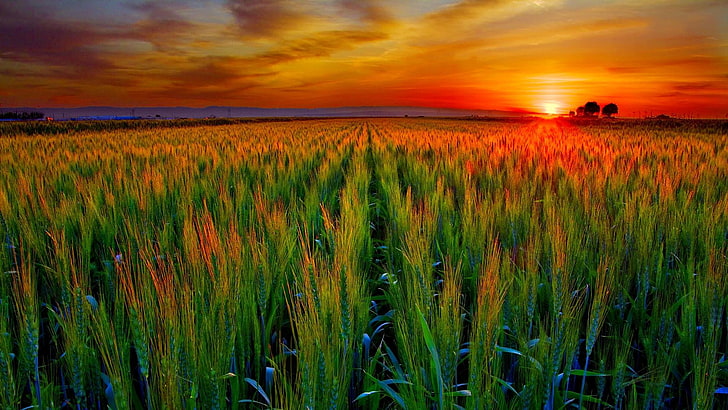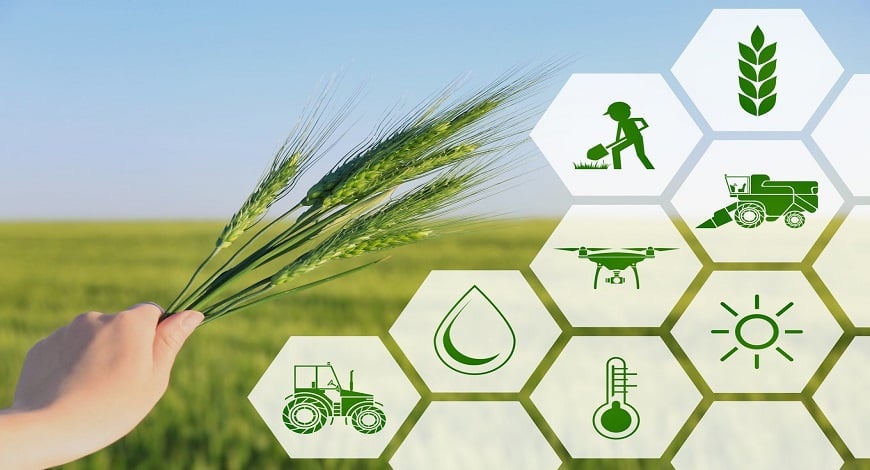

Agriculture in India started with the Indus valley
civilization. It is mentioned in the history of India that rice
and cotton were the two crops that were cultivated in the Indus
valley. According to Bhumivargha and Indian Sanskrit text, the
agricultural land is divided into 12 categories, Urvara, Ushara,
Maru, Aprahata, Shadvala, Panikala, Jalaprayah, Kachchaha,
Sharkara, Sharkaravati, Nadimutruka, and Devmatruka. In India
agriculture exist since 9000 BC. After the independence of India,
the country has made immense development in the agricultural
sector. During the mid-1960 India relied on imported food from
foreign countries to meet their domestic requirements but the
drought of 1965 and 1966 convinced India to reform its agriculture
policy....
Read more at:
Agriculture in India
In 2014 India ranked as the world’s largest producer of fruits
like Banana mango guava lemon papaya and vegetables like chickpea
and okra, major spices like Ginger chili pepper, fibrous crops
such as jute, and staples such as millet and castor oil seed. The
major reason for the success of India in agriculture is the
irrigation network of India. The irrigation network includes major
and minor canals from rivers rainwater harvesting and groundwater
systems. From all of these the groundwater system is the largest
irrigation network in India. The improvement in the irrigation
network over the last 50 years has helped India to improve food
security and reduce its dependence on monsoon. One of the major
roles in irrigation networks is played by dams. Dams provide
drinking water and control and prevent drought-related damage to
agriculture. 60% of the water which comes from all the water
channels is consumed by rice and sugar crops. India is among the
top 3 global producers of the major crops including wheat, rice,
cotton, fruits, vegetables, and pulses. The irrigated crop area of
India is 8.26 million hectares which is the largest in the world
and the arable land is 159.7 million hectares which is the second
largest in the world....
Read more at:
Crops and Irrigation Networks in India

Agriculture, with its allied sectors, is unquestionably the
largest livelihood provider in India, more so in the vast rural
areas. It also contributes a significant figure to the Gross
Domestic Product (GDP). Sustainable agriculture, in terms of
food security, rural employment, and environmentally sustainable
technologies such as soil conservation, sustainable natural
resource management and biodiversity protection, are essential
for holistic rural development. Indian agriculture and allied
activities have witnessed a green revolution, a white
revolution, a yellow revolution and a blue revolution. This
section provides the information on agriculture produces;
machineries, research etc. Detailed information on the
government policies, schemes, agriculture loans, market prices,
animal husbandry, fisheries, horticulture, loans & credit,
sericulture etc. is also available.
Agriculture is the art and science of cultivating the soil,
growing crops and raising livestock. It includes the preparation
of plant and animal products for people to use and their
distribution to markets. Agriculture provides most of the
world’s food and fabrics. Cotton, wool, and leather are all
agricultural products. Agriculture also provides wood for
construction and paper products. These products, as well as the
agricultural methods used, may vary from one part of the world
to another.

India developed the concept of farmer producer organisations
(FPO) in early 2000s to help small farmers gain economies of
scale and improve their market standing by negotiating
collectively. FPOs can be a registered company (farmer producer
company or FPC) or a cooperative, among others. In 2019, the
Government of India launched a scheme, Formation and Promotion
of 10,000 Farmer Produce Organisations, to form and promote
10,000 new FPOs in the country by 2024, with a budgetary
provision of Rs 6,865 crore. Under this scheme, the formation
and Promotion of FPOs is to be done through nine implementing
agencies, such as Small Farmers Agri-Business Consortium (SFAC),
National Cooperative Development Corporation (NCDC) and National
Bank for Agriculture and Rural Development (NABARD).
Implementing agencies will engage cluster-based business
organisations (CBBOs), introduced under the scheme, to
aggregate, register and provide professional hand-holding
support to FPOs for a period of five years. CBBOs have been
empanelled and engaged by implementing agencies. CBBOs will be
the platform for an end-to-end knowledge for all issues related
to FPO promotion. Any legal entity registered in India and in
existence for past three years is eligible to be a CBBO. The
agency should have a minimum average turnover / utilisation of
funds of at least Rs 2 crore for the plains and Rs 1 crore for
Himalayan and northeastern region during the past three years,
with a positive net worth. Institutions promoted by Public
Sector Agricultural Universities, Indian Council of Agricultural
Research / Krishi Vikas Kendras or other similar institutions of
Central / state governments are exempt from this requirement.
Implementation agencies pay CBBOs Rs 25 lakh per FPO over a
period of five years for the cost incurred in formation and
incubation of the FPO. The process of creation of FPO starts
with CBBO identifying a produce cluster area (a contiguous or
compact geographical area, with similar agricultural produce)
and undertaking a feasibility survey. Next, it mobilises
potential producers and shares with them the business idea,
viability, market size and risks. CBBO then prepares a business
plan with participation of farmer members. The business plan
will cover the entire end-to-end value chain, including those of
production, post-production, marketing, value addition and
exports. The Union agriculture ministry mandated SFAC, an
autonomous registered society promoted by the ministry, to
facilitate this process and to support the state governments in
the formation of FPOs.



